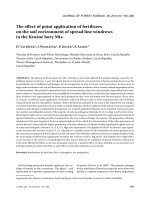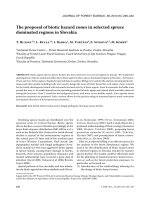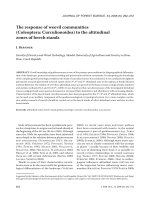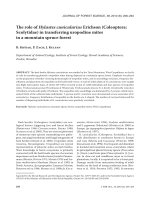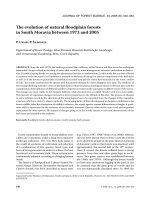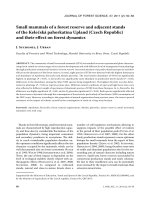Báo cáo lâm nghiệp: "The effects of elevated CO 2 and water stress on whole plant CO 2 exchange, carbon allocation and osmoregulation in oak seedlings" docx
Bạn đang xem bản rút gọn của tài liệu. Xem và tải ngay bản đầy đủ của tài liệu tại đây (721.73 KB, 13 trang )
Original
article
The
effects
of
elevated
CO
2
and
water
stress
on
whole
plant
CO
2
exchange,
carbon
allocation
and
osmoregulation
in
oak
seedlings
P
Vivin
JM
Guehl*
A
Clément,
G Aussenac
Unité
écophysiologie
forestière,
équipe
bioclimatologie
et
écophysiologie,
Centre
de
Nancy,
Inra,
54280
Champenoux,
France
(Received
18
January
1995;
accepted
29
June
1995)
Summary—
Seedlings
of
Quercus robur L
grown
under
present
(350
μmol
mol
-1
)
or
twice
the
present
(700
μmol
mol
-1
)
atmospheric
CO
2
concentrations,
were
either
maintained
well-watered
or
subjected
to
a
drought
constraint
late
in
the
growing
season
(25
August
1993).
Despite
an
initial
stimulation
of
biomass
growth
(+44%)
by
elevated
CO
2,
there
was
no
significant
difference
in
plant
dry
weight
at
the
end
of
the
growing
season
(15
October
1993)
between
the
two
CO
2
treatments,
irrespective
of
water-
ing
regime.
Under
drought
conditions,
although
there
was
no
growth
increase
in
response
to
elevated
CO
2
concentration,
there
was
a
stimulation
in
net
photosynthesis.
In
addition,
the
respiration
rate
of
the
root
+
soil
system
(root
dry
matter
basis)
was
slightly
lower
in
the
elevated
than
in
the
ambient
CO
2
con-
centration.
These
results,
together
with
the
results
from
short-term
13
C
labelling,
suggest
enhanced
plant
carbon
losses
through
processes
not
assessed
here
(aerial
respiration,
root
exudation,
etc)
under
elevated
CO
2
concentration.
In
the
droughted
conditions,
new
carbon
relative
specific
allocation
val-
ues
(RSA)
were
greater
under
elevated
CO
2
than
under
ambient
CO
2
concentration
in
both
leaf
and
root
compartments.
Osmotic
potentials
at
full
turgor
(π
o)
were
lowered
in
response
to
water
stress
in
leaves
by
0.4
MPa
for
the
elevated
CO
2
treatment
only.
In
roots,
osmotic
adjustment
(0.3
MPa)
occurred
in
both
the
CO
2
treatments.
elevated
CO
2
/ water
stress
/
osmoregulation
/
carbon
allocation
/
Quercus
robur
Résumé —
Effets
de
l’augmentation
de
la
concentration
atmosphérique
en
CO
2
et
d’un
déficit
hydrique
sur
les
échanges
gazeux,
la
répartition
carbonée
et
l’osmorégulation
de
semis
de
chêne.
Des
semis
de
chêne
pédonculé
(Quercus
robur
L)
cultivés
sous
des
concentrations
atmo-
sphériques
en
CO
2
de
350
ou
700
μmol
mol
-1
ont
été,
pour
moitié,
soit
bien
alimentés
en
eau,
soit
sou-
mis
à
une
sécheresse
appliquée
tardivement
dans
la
saison
de
végétation
(25
août
1993).
En
dépit
d’une
première
phase
de
stimulation
de
la
production
de
biomasse
(+44
%,
30 juillet
1993)
par
le
CO
2,
aucune
différence
significative
dans
la
biomasse
des
plants
entre
les
deux
traitements
CO
2
n’a
été
obser-
*
Correspondence
and
reprints
vée
à
la
fin
de
la
saison
de
végétation
(15
octobre
1993),
ceci
quel
que
soit
le
régime
hydrique.
En
condi-
tions
de
sécheresse,
l’assimilation
nette
de
CO
2
fut
stimulée
par
le
CO
2,
malgré
l’absence
de
stimu-
lation
sur
la
croissance.
Par
ailleurs,
le
taux
de
respiration
du
système
racine-sol
(rapportée
à
la
matière
sèche
racinaire)
était
légèrement
plus
faible
sous
CO
2
élevé
que
sous
CO
2
ambiant.
Ces
résultats,
ajoutés
aux
résultats
de
marquages
13CO
2
à
court
terme
suggèrent
des
pertes
carbonées
aug-
mentées
sous
CO
2
élevé,
par
l’intermédiaire
de
processus
non
étudiés
ici
(respiration
aérienne,
exu-
dation
racinaire, ).
En
conditions
de
sécheresse,
les
valeurs
de
répartition
relative
spécifique
du
nou-
veau
carbone
étaient
plus
importantes
sous
CO
2
élevé
que
sous
CO
2
normal,
à
la
fois
dans
les
compartiments
foliaire
et
racinaire.
Les
potentiels
osmotiques
à
pleine
turgescence
(π
0)
étaient
dimi-
nués
en
réponse
au
stress
hydrique
dans
les
feuilles
de
0,4
MPa
uniquement
pour
le
traitement
CO
2
à
700
μmol
mol
-1
.
Dans
les
racines,
un
ajustement
osmotique
(0,3
MPa)
était
observé
pour
les
deux
traitements
CO
2.
CO
2
/ sécheresse / osmorégulation / répartition
carbonée
/ Quercus
robur
INTRODUCTION
Osmoregulation,
ie,
the
lowering
of
osmotic
potential
by
the
net
increase
in
intracellular
organic
and
mineral
solutes
in
response
to
water
deficit,
is
one
of
the
processes
by
which
changes
in
atmospheric
CO
2
can
interfere
with
drought
adaptation
features
of
C3
plants
(Conroy
et
al,
1988;
Chaves
and
Pereira,
1992;
Tschaplinski
et
al,
1993;
Tyree
and
Alexander,
1993).
Under
drought
conditions,
osmotic
adjust-
ment
on
the
one
hand
and
growth
and
metabolic
processes
on
the
other
may
com-
pete
for
a
limited
supply
of
carbon
(Munns
and
Weir,
1981).
Thus,
it
might
be
hypoth-
esized
that
increasing
atmospheric
CO
2
concentration
favours
osmotic
adjustment
through
enhanced
carbon
supply
to
the
dif-
ferent
plant
components
and
increased
organic
solute
concentrations.
However,
elevated
CO
2
concentrations
often
lead
to
reduced
total
mineral
ion
concentrations
in
the
plant
tissues
(Conroy,
1992;
Overdieck,
1993).
The
responses
of
mineral
solute
con-
centrations
to
elevated
CO
2
have
not
yet
been
addressed
in
tree
species.
The
ques-
tion
whether,
in
response
to
elevated
CO
2.
concentration,
reduced
mineral
solute
con-
centrations
may
offset
the
increase
in
organic
solute
remains
open.
In
the
present
study,
we
investigated
the
responses
of
pedunculate
oak
(Quercus
robur L)
seedlings
to
elevated
atmospheric
CO
2
concentration
and
water
stress.
More
precisely,
i)
carbon
allocation
(
13CO
2
labelling)
to
the
different
plant
components
was
assessed
in
relation
to
the
whole
plant
CO
2
exchange
and
ii)
the
relationships
between
alterations
in
carbon
allocation
and
in
osmoregulation
were
investigated.
MATERIALS
AND
METHODS
Plant
material
Quercus
robur
L
acorns
were
collected
in
the
Forêt
Domaniale
de
Manoncourt
(Meurthe
et
Moselle,
eastern
France)
during
autumn
1992
and
kept
overwinter
in
a
cold
chamber
at
-1 °C.
From
March
1993,
acorns
were
planted
in
5
000
cm
3
cylindrical
plastic
containers
(20
cm
deep)
filled
with
a
sphagnum
peat-sand
mixture
(1:1,
v:v)
and
fertilized
with
delayed
release
Nutricote
100
(NPK
13-13-13
+
trace
elements;
5
kg
m
-3).
Pots
were
placed
in
two
transparent
tunnels
located
in
a
glasshouse
at
INRA
Champenoux.
Seedlings
were
exposed
to
either
ambient
(350
±
30
μmol
mol
-1
CO
2)
or
elevated
carbon
dioxide
concentration
(700
±
50
μmol
mol
-1
CO
2
),
and
were
watered
weekly.
The
CO
2
control
and
mon-
itoring
system
as
well
as
the
growth
conditions
have
been
described
previously
by
Guehl
et
al
(1994)
and
Vivin
et
al
(1995).
Irradiance
was
about
60%
of
the
outside
conditions.
Average
daily
temperatures
were
26 °C
(maximum)
and
11
°C
(minimum);
relative
humidity
was
70%.
From
25
August
1993, 15
seedlings
were
ran-
domly
assigned
to
well-watered
or
water-stressed
treatments,
and
water
supply
was
withheld
in
the
latter
treatment.
Direct
evaporation
from
the
con-
tainers
was
prevented
by
covering
the
substrate
with
waxed
cardboard
disks
and
the
transpira-
tional
water
use
of
the
seedlings
was
determined
gravimetrically.
Whole
plant
water
use
did
not
dif-
fer
among
the
CO
2
treatments
(fig
1)
during
the
soil
drying
cycle.
At the
end
of
the
experiment,
the
water-stressed
seedlings
of
both
CO
2
con-
centration
conditions
displayed
water
use
values
amounting
to
25%
of
the
nonstressed
treatments.
For
a
given
date
during
the
drying
cycle,
a
tran-
spiration
index —
considered
as
a
measure
of
internal
plant
drought
constraint—was
calculated
at
the
individual
plant
level
as
the
ratio
actual
water
use
rate/maximum
water
use
rate
(julian
day
241,
fig
1).
On
15
October
(julian
day
288),
the
following
factors
were
assessed:
the
allocation
of
recently
fixed
carbon,
whole
plant
CO
2
exchange,
growth,
water
relations
and
mineral
solute
concentrations.
Water
relations
Predawn
leaf
water
potential
(Ψ
wp
,
MPa)
was
determined
with
a
Scholander
pressure
cham-
ber.
In
order
to
assess
osmotic
adjustment,
osmotic
potentials
of
the
sap
expressed
from
leaves
or
root
tips
in
the
actual
plant
conditions
(π)
and
at
full
turgor
(π
o)
were
measured.
To
achieve
the
full
turgor
state,
one
to
three
leaves,
or
some
root
tips,
were
saturated
in
distilled
water
for
8
h
in
darkness.
After
blotting
with
filter
paper,
the
plant
material
was
transferred
into
1
mL
syringes
and
immediately
frozen
in
liquid
nitrogen.
Samples
were
then
kept
deep
frozen.
Before
the
sap
was
expressed
in
the
syringes,
the
leaves
or
root
tips
were
thawed
out
30
min
at
room
temperature.
Osmotic
potential
of
the
sap
(10
μl)
was
mea-
sured
with
a
calibrated
vapour
pressure
osmome-
ter
(Wescor
5500,
Logan,
UT,
USA).
Assuming
the
invariability
of
the
nonosmotic
water
fraction
during
drought,
relative
water
content
(RWC)
was
calculated
using
the
following
formula:
Growth
and
biomass
Leaf
area
was
measured
using
an
area
meter
(ΔT
Devices,
UK).
Leaves,
stems
and
roots
were
sep-
arated,
weighed
and
oven
dried
at
60 °C
for
48
h
before
dry
mass
determination.
Water
content
(g
H2O
per
g
dry
mass)
of
the
plant
compartments
was
calculated
from
the
fresh
and
dry
masses.
Biomass
partitioning
between
the
plant
com-
partments
was
assessed
by
determining
i)
the
leaf
mass
ratio
(LMR,
leaf
dry
mass/whole
plant
dry
mass,
g
g
-1),
ii)
the
stem
mass
ratio
(SMR,
stem
dry
mass/whole
plant
dry
mass,
g
g
-1),
iii)
the
root
mass
ratio
(RMR,
root
mass/whole
plant
mass,
g
g
-1
)
and
iv)
the
root:shoot
ratio
(root
mass/[leaf
mass
+
stem
mass]).
Specific
leaf
mass
ratio
(SLA,
dm
2
g
-1
)
and
leaf
area
ratio
(LAR,
dm
2
g
-1
)
were
calculated
as
the
leaf
area
to
leaf
mass
and
the
leaf
area
to
plant
mass,
respectively.
Carbon
allocation
and
whole
plant
CO
2
exchange
The
CO
2
exchange
and
13CO
2
labelling
experi-
ments
were
conducted
in
a
climatized
phytotronic
chamber
using
a
semi-closed
13
C
labelling
system
described
in
detail
elsewhere
(Vivin
et
al,
1995).
Total
CO
2
concentration
in
the
chamber
was
con-
stantly
maintained
at
either
350
or
700
μmol
mol
-1
CO
2.
The
short-term
(8
h
duration)
13CO
2
labelling
(1.5%
13C)
was
performed
using
eight
plants.
To
ensure
that
most
of
the
13CO
2
injected
was
absorbed
by
the
plants
(Mordacq
et
al,
1986)
and
to
avoid
effects
on
air
δ
13
C
due
to
carbon
iso-
tope
discrimination
by
the
plants
(Farquhar
et
al,
1989),
plants
were
left
in
the
chamber
after
the
cessation
of
CO
2
injection
until
the
CO
2
com-
pensation
point
was
reached.
The
incorporation
of
13
C
into
individual
plant
parts
was
determined
12
h
(three
plants)
and
48
h
(five
plants,
2
nights
and
1
day)
after
the
beginning
of
13CO
2
assimi-
lation.
Four
to
six
unlabelled
plants
were
also
harvested
to
assess
natural
13
C
abundances.
Relative
abundance
of
13
C
in
plant
samples
was
determined
using
an
isotope
ratio
mass
spec-
trometer
(Finnigan
MAT,
Delta
S).
Powdered
plant
tissues
were
combusted
before
analysis
(He
+
3%
O2,
1
050
°C)
and
their
carbon
as
well
as
nitrogen
concentrations
were
measured
using
an
elemental
analyser.
Carbon
isotope
ratio
data
were
expressed
in
terms
of
the
conventional
δ
notation
according
to
the
relationship:
where
Rs
and
R
PDB
refer
to
the
13C/12
C
ratio
in
the
sample
and
in
the
Pee-Dee
Belemnite
stan-
dard,
respectively.
They
were
also
converted
into
atom
percent
(Atom%)
defined
as:
To
appreciate
the
incorporation
in
a
pool
rel-
ative
to
a
maximum
possible
value,
we
used
rel-
ative
specific
allocation
(RSA)
defined
as:
where
subscripts
SL
and
SC
refer
to
samples
from
labelled
and
from
nonlabelled
plants,
respec-
tively;
subscripts
AL
and
AC
refer
to
air
samples
taken
in
the
exposure
chamber
and
in
the
CO
2
tunnels,
respectively.
Simultaneously
to
the
13CO
2
labelling
exper-
iment,
carbon
dioxide
exchange
was
separately
measured
on
the
below-ground
and
the
above-
ground
compartments
of
the
plant-soil
system.
The
diurnal
course
of
net
CO
2
assimilation
rates
was
determined
as
the
time
course
of
CO
2
flow
rates
entering
the
chamber;
the
below-ground
CO
2
efflux
rates
were
calculated
from
the
slope
of
the
linear
regression
between
time
and
CO
2
con-
centration
in
the
root
compartment
(Vivin
et
al,
1995).
For
technical
reasons,
CO
2
efflux
from
the
aerial
plant
parts
during
the
night
could
not
be
measured.
Soluble
minerals
analysis
Soluble
inorganic
ion
concentrations
(K,
Mg,
Mn,
Na,
Ca,
P,
S)
were
determined
by
ICP
spec-
trophotometry.
Five
hundred
mg
of
powdered
tis-
sue
were
extracted
twice
with
25
+
25
mL
of
ultra-
pure
water
for
1
h
at
room
temperature.
Solutions
were
analyzed
on
plasma
torch
(JY38
Plus).
Results
were
expressed
on
a
water
volume
basis
(mmol
L
-1
)
either
in
the
actual
plant
water
status,
or
at
full
turgor.
Data
analysis
Statistical
differences
between
treatments
were
analysed
by
one-
or
two-way
analyses
of
vari-
ance
(ANOVA)
followed
by
Fisher’s
PLSD
test.
RESULTS
Water
relations
At
the
end
of
the
experiment,
the
plants
in
the
well-watered
treatments
had
similar
leaf
Ψ
wp
values
(-0.93
MPa)
under
ambient
and
elevated
CO
2
concentration
(table
I).
In
con-
trast,
the
late
season
soil
water
stress
applied
here
decreased
Ψ
wp
in
both
CO
2
treatments,
and
this
effect
was
more
pro-
nounced
under
elevated
CO
2
(-2.5
MPa)
than
under
ambient
CO
2
concentration
(-1.7
MPa).
The π
o
values
were
about
twice
more
negative
in
leaves
than
in
roots.
In
leaves,
water
stress
only
lowered
π
o
(by
approximately
0.4
MPa)
in
the
elevated
CO
2
treatment
(table
I).
At
the
individual
plant
significant
positive
correlations
were
only
found
under
elevated
CO
2
between
π
o
and
either
transpiration
index
or
Ψ
wp
(fig
2).
In
roots,
there
was
osmotic
adjustment
(π
o
decrease
of
about
0.3
MPa)
in
response
to
drought,
and
this
response
was
not
affected
by
the
CO
2
concentration
(table
I).
Growth
and
biomass
At
the
end
of
the
growing
season
(15
Octo-
ber
1993),
all
the
plants
were
in
a
rest
phase.
Under
ambient
CO
2,
92
and
8%
of
the
plants
had
produced
three
and
four
growth
flushes,
respectively,
whereas
under
elevated
CO
2,
these
proportions
were
71
and
29%
(data
not
shown,
Vivin
et
al,
1995).
Despite
an
initial
stimulation
of
biomass
growth
stimulation
(+44%)
by
elevated
CO
2
until
30
July,
there
was
no
significant
dif-
ference
in
plant
dry
weight
at
the
end
of
the
growing
season
(P
= 0.402,
October
15)
between
the
two
CO
2
treatments,
whatever
the
watering
regime.
Drought
reduced
whole
plant
biomass
accumulation
in
both elevated
and
ambient
CO
2
treatments
by
a
factor
of
0.82
and
0.73,
respectively.
Stem
mass
ratio
was
increased
by
elevated
CO
2
in
both
watering
regimes
(P =
0.003),
whereas
RMR
and
the
R:S
ratio
were
significantly
decreased
(P
< 0.001).
Drought
did
not
affect
the
different
biomass
partitioning
parameters.
On
15
October,
plant
leaf
area
(P =
0.043),
SLA
(P
= 0.018)
and
LAR
(P
=
0.029;
table
II)
were
significantly
increased
by
elevated
CO
2.
In
both
watering
regimes,
the
elevated
CO
2
treatment
had
no
significant
effect
on
the
whole
plant
N
concentration
(P=
0.340;
table
II).
However,
on
leaf
area
basis,
nitro-
gen
content
was
significantly
decreased
(P =
0.008)
by
elevated
CO
2
(-8
and
-10%
under
well-watered
and
droughted
treat-
ments,
respectively).
The
whole
plant
C:N
ratio
was
unaffected
by
water
stress
or
increasing
CO
2
(P =
0.726).
CO
2
gas
exchange
On
15
October,
in
the
well-watered
treat-
ments,
net
CO
2
assimilation
rate
(A,
μmol
m
-2
s
-1
)
was
not
stimulated
by
increasing
CO
2
(fig
3).
On
a
plant
basis,
the
respira-
tory
CO
2
evolution
of
the
root-soil
com-
partment
was
quite
similar
in
ambient
and
elevated
CO
2
treatments
(fig
4).
However,
on
a
root
dry
mass
basis,
slightly
lower
val-
ues
were
exhibited
in
the
elevated
CO
2
treatment.
The
water
stress
resulted
in
a
decrease
in
A
in
both
CO
2
treatments,
but
the
decrease
was
less
underelevated
than
underambient
CO
2
(fig
3).
Apparently,
ele-
vated
CO
2
stimulated
net
assimilation
rate
in
the
droughted
plants.
Root-soil
respiration,
on
a
plant
basis,
was
slightly
decreased
by
drought
irrespective
of
the
CO
2
treatment
(about
-30%).
On
a
root
dry
mass
basis,
mean
root-soil
respiration
values
were
slightly
lower
under
700
than
under
350
μmol
mol
-1
CO
2.
Carbon
isotope
composition
and
new
carbon
allocation
Carbon
isotope
composition
of
all
nonla-
belled
plants
was
on
average
17‰
more
negative
in
plants
in
elevated
CO
2
than
in
ambient
CO
2
(fig
5).
Such
a
large
difference
can
only
be
accounted
for
by
differences
in
source
air
isotopic
composition
between
the
two
tunnels
and
not
by
differences
in
iso-
tope
discrimination
by
the
plants
(Guehl
et
al,
1994;
Picon
et
al,
1996;
Vivin
et
al,
1995).
Carbon
isotope
composition
of
the
labelled
plants
was
significantly
higher
than
that
of
the
nonlabelled
plants
whatever
the
CO
2
concentration
or
water
treatment
(P
< 0.001;
fig
5).
Four
hours
after
the
end
of
labelling,
leaf
δ
13
C
was
significantly
increased
in
all
treat-
ments
as
compared
with
the
control
plants
(P
< 0.001).
However,
less
new
carbon
was
incorporated
in
the
leaf
compartment
of
the
droughted
plants
grown
in
ambient
CO
2
concentration
as
reflected
by
the
lower
RSA
values
displayed
in
this
treatment.
In
the
drought
treatments
and
40
h
after
the
end
of
labelling,
the
difference
in
leaf
δ
13
C
between
the
labelled
and
control
plants,
and
RSA,
were
still
higher
in
the
elevated
than
in
the
ambient
CO
2
concentration
(p
<
0.001).
In
the
roots
of
the
droughted
plants
grown
under
ambient
CO
2
concentration,
no
sig-
nificant
13
C
labelling
(P =
0.608)
was
found,
whereas
in
the
droughted
plants
from
the
elevated
CO
2
treatment
δ
13
C
was
less
neg-
ative
in
both
4
and
40
h
after
the
labelling
(P
= 0.030).
At
the
whole
plant
level,
a
clear
discrep-
ancy
existed
between
the
two
CO
2
treat-
ments:
i)
For
the
drought
treatments,
the
labelling
was
only
effective
in
the
elevated
CO
2
treatment
(P
<
0.001).
ii)
In
the
ele-
vated
CO
2
treatments,
a
significant
decrease
in
δ
13
C
and
RSA
was
found
between
4
and 40
h
after
the
labelling
(P
=
0.031),
whereas
in
the
ambient
CO
2
treat-
ments
no
decrease
was
observed
(P
=
0.941).
Soluble mineral
concentrations
In
the
leaves
of
the
well-watered
plants,
total
soluble
mineral
concentration
accounted
for
about
45%
of
osmotic
potential
at
full
tur-
gor
irrespective
of
the
CO
2
concentration
(table
I).
Potassium
and
magnesium
were
the
most
important
analyzed
osmotic
solutes.
In
the
roots
of
the
well-watered
plants,
soluble
minerals
contributed
less
to
the
osmotic
potential
at
full
turgor
(18
and
22%
in
the
350
and
700
μmol
mol
-1
CO
2
treatments,
respectively).
In
root
tips,
total
concentration
of
mineral
ions
at
full
turgor
was
significantly
increased
by
water
stress
in
both
CO
2
treatments
(P =
0.001),
whereas
in
the
leaves
this
effect
occurred
in
the
ele-
vated
CO
2
treatment
only
(P =
0.049).
The
respective
contributions
of
the
mineral
solutes
to
osmotic
potential
were
not
sig-
nificantly
affected
by
drought
(table
I).
DISCUSSION
Despite
the
initial
biomass
stimulation
(+44%)
in
July,
there
was
no
significant
enhancement
of
plant
biomass
due
to
a
dou-
bling
of
the
ambient
atmospheric
CO
2
con-
centration
in
well-watered
pedunculate
oak
seedlings
at
the
end
of
the
growing
period
(table
II).
This
lack
of
response
is
in
con-
trast
with
the
general
trend
(+68%)
observed
in
tree
species
under
optimal
nutrition
and
water
supply
(Ceulemans
and
Mousseau,
1994).
In
the
genus
Quercus,
a
wide
range
of
growth
stimulation
values
has
been
reported
in
the
literature:
1.22
(Norby
and
O’Neill,
1989)
and
1.86
(Norby
et
al,
1986)
in
Q
alba,
2.21
in
Q
rubra
(Lindroth
et
al,
1993), 2.38
in
Q petraea
(Guehl
et
al,
1994).
Harvest
dates
may
affect
the
interpreta-
tions
of
elevated
CO
2
experiments
(Cole-
man
and
Bazzaz,
1992).
The
strong
initial
enhancement
of
growth
observed
in
response
to
long-term
CO
2
enrichment
has
been
shown
to
decline
in
time
(Tolley
and
Strain,
1985;
Norby
et
al,
1987;
Bazzaz
et
al,
1989;
Retuerto
and
Woodward,
1993;
Vivin
et
al,
1995).
It
has
often
been
suggested
that
pot
size,
pot
shape,
concentrations
and
total
amounts
of
nutrients
in
the
pots
may
affect
the
assessment
of
the
responses
of
plants
(Arp,
1991;
Idso and
Kimball,
1991;
Thomas
and
Strain,
1991)
and
cause
the
growth-stimulating
effect
to
be
transient
(Poorter,
1993).
In
the
present
study,
the
Q
robur seedlings
were
grown
under
nonlim-
iting
nutrient
concentrations
on
a
well-aer-
ated
growing
substrate
and
roots
had
not
completely
filled
the
pots
at
the
end
of
the
growing
season,
leading
us
to
consider
it
unlikely
that
oak
root
growth
could
have
been
constrained
by
pot
size
and
nutrient
availability.
In
terms
of
global
growth
analysis,
the
growth-stimulating
effect
of
elevated
CO
2
observed
over
a
growing
season
will
depend
on
the
duration
of
the
period
during
which
relative
growth
rate
(RGR)
is
stimultated
(Coleman
and
Bazzaz,
1992;
Poorter,
1993).
It
has
already
been
demonstrated
that
RGR
was
often
stimulated
by
elevated
CO
2
only
during
the
early
stages
of
the
growing
period,
and
that
after
there
was
no
effect
or
sometimes
an
inhibition
of
RGR
(Neales
and
Nicholls,
1978),
as
observed
in
the
present
species
(Vivin
et
al,
1995).
At
the
end
of
the
growing
period
no
sig-
nificant
difference
in A
was
found
between
350
and
700
μmol
mol
-1
CO
2
concentra-
tions
under
well-watered
conditions
(fig
3).
The
lack
of
a
stimulation
of A
reflects
a
long-
term
downward
acclimation
of
photosyn-
thetic
capacity
under
the
elevated
CO
2,
a
response
already
found
in
Quercus
robur
by
Bunce
(1992).
Moreover,
below-ground
(root
+
soil)
respiration
rates
expressed
on
a
root
dry
mass
basis
were
slightly
lower
under
elevated
than
ambient
CO
2
treatment,
as
often
reported
on
whole
plant
tree
species:
Quercus prinus
(Bunce,
1992),
Castanea
sativa
(Mousseau,
1993)
or
Acer
saccharum
(Reid
and
Strain,
1994).
For
the
droughted
plants,
the
lack
of
growth
response
to
elevated
CO
2
was
in
contrast
with
the
stimulation
in
both
A
at
the
leaf
and
whole
plant
levels
(fig
3)
and
the
intensity
of
entry
of
new
carbon
in
the
leaves
4
h
after
the
end
of
the
labelling
(fig
5).
This
discrepancy
is
reinforced
by
the
fact
that
below-ground
respiration
(R
m)
was
slightly
lower
at
the
high
CO
2
level
than
under
ambi-
ent
CO
2
(fig
4).
As
it
is
suggested
by
the
decrease
in
whole
plant
δ
13
C
values
between
4
and
40
h
after
the
end
of
the
labelling,
greater
new
carbon
losses
at
high
CO
2
concentration
could
have
contributed
to
the
lack
of
growth
response
to
elevated
CO
2.
Further
investigations,
including
above-
ground
respiration
and
direct
root
exuda-
tion
measurements
(Norby
et
al,
1987;
Rouhier
et
al,
1994),
are
needed
to
sub-
stantiate
this
hypothesis.
Plants
grown
with
limiting
water
supply
generally
allocate
relatively
more
dry
matter
to
the
root
compartment
(Poorter,
1993);
this
effect
would be
advantageous
for
the
acquisition
of
water
under
field
conditions
(Gifford,
1979;
Tyree
and
Alexander,
1993).
Thus,
it
is
relevant
to
assess
whether
plant
water
status
can
be
improved
by
a
greater
carbon
allocation
to
the
roots
in
high
CO
2
conditions
(Morison,
1993).
In
the
present
study,
drought
had
no
apparent
effect
on
carbon
partitioning
parameters
(R:S
ratio,
RMR)
calculated
from
the
final
biomass
results.
This
could
be
explained
by
the
fact
that
water
limitation
was
applied
late
in
the
growing
season.
However,
an
original
result
of
this
study
is
that
40
h
after
the
end
of
the
labelling
period,
the
proportion
of
new
carbon
in
both
leaves
and
roots
of
the
droughted
plants
was
significantly
higher
under
700
μmol
mol
-1
CO
2
than
under
350
μmol
mol
-1
CO
2.
This
suggests
that
the
amount
of
carbon
available
for
growth
and
osmoregulation
were
greater
under
elevated
CO
2
treatment,
as
suggested
by
Masle
(1992).
Indeed,
osmoregulation
was
only
observed
in
leaves
under
high
CO
2
and
was
not
entirely
accounted
for
by
the
K+
con-
centrations
(table
I).
A
stimulation
of
osmoregulation by
elevated
CO
2
was
also
reported
in
Pueraria
lobata
leaves
(Sasek
and
Strain,
1989);
however,
no
significant
effect
of
the
CO
2
concentration
was
found
in
several
tropical
trees
(Reekie
and
Bazzaz,
1989)
or
in
Pinus
taeda
(Tschaplinski
et
al,
1993).
Further
investigations
are
needed
to
characterize
the
other
solutes
involved
in
osmoregulation.
Osmotic
adjustment
is
com-
monly
associated
with
starch
breakdown
and
concomittant
increase
in
low
molecu-
lar
weight
organic
solutes
(Tyree
and
Jarvis,
1982;
Morgan,
1984).
Preliminary
13
C
NMR
spectrometry
analyses
(data
not
shown)
revealed
that
soluble
carbohydrates
(glu-
cose,
fructose,
sucrose),
organic
acids
(quinic
acid,
malic
acid),
free
amino
acids
(arginine,
glutamine)
were
main
solutes
in
the
Q
robur
seedlings.
Despite
the
stimulating
effect
of
elevated
CO
2
on
leaf
osmoregulation,
the
depressing
effect
of
drought
on
growth
was
not
allevi-
ated
as
has
been
proposed
(Chaves
and
Pereira,
1992;
Stulen
and
Den
Hertog,
1993;
Tyree
and
Alexander,
1993).
This
shows
that
osmoregulation
was
not
a
crucial
factor
to
consider
in
our
situation.
Whether
this
conclusion
can
be
extended
to
situations
with
drought
constraints
applied
early
in
the
growing
season
remains
an
open
question.
ACKNOWLEDGMENTS
This
work
was
supported
by
the
European
Union
through
the
project
"Water-use
efficiency
and
mechanisms
of
drought
tolerance
in
woody
plants
in
relation
to
climate
change
and
elevated
CO
2
’’
(project
EV5V-CT92-0093),
by
the
Region
Lor-
raine
and
the
French
Ministry
of
Environment.
The
technical
skill
in
plant
sampling
(B
Clerc
and
F
Willm,
INRA
Nancy),
in
13
C
analyses
(H
Casabi-
anca,
CNRS
Vernaison),
and
in
mineral
analy-
ses
(M
Bitsch
and
C
Brechet,
INRA
Nancy)
is
gratefully
acknowledged.
REFERENCES
Arp
WJ
(1991)
Effects
of
source-sink
relations
on
pho-
tosynthetic
acclimation
to
elevated
CO
2.
Plant
Cell
Environ
14,
869-875
Bazzaz
FA,
Coleman
JS,
Morse
SR
(1989)
Growth
responses
of
seven
co-occuring
tree
species
of
the
north-eastern
United States
to
elevated
CO
2.
Can
J For
Res
20, 1479-1484
Bunce
JA
(1992)
Stomatal
conductance,
photosynthesis
and
respiration
of
temperate
deciduous
tree
species
grown
outdoors
at
an
elevated
concentration
of
car-
bon
dioxide.
Plant Cell Environ
15,
541-549
Ceulemans
R,
Mousseau
M
(1994)
Effects
of
elevated
atmospheric
CO
2
on
woody
plants.
New
Phytol
127,
425-446
Chaves
MM,
Pereira
JS
(1992)
Water
stress,
CO
2
and
climate
change.
J Exp Bot 43,
1131-1139
Coleman
JS,
Bazzaz
FA
(1992)
Effects
of
CO
2
and
tem-
perature
on
growth
and
resource
use
of
co-occur-
ring
C3
and
C4
annuals.
Ecology 73,
1244-1259
Conroy
JP
(1992)
Influence
of
elevated
atmospheric
CO
2
concentrations
on
plant
nutrition.
Aust J Bot 40,
445-456
Conroy JP,
Virgona JM,
Smillie
RM,
Barlow
EW (1988)
Influence
of
drought
acclimation
and
CO
2
enrich-
ment
on
osmotic
adjustment
and
chlorophyll
a
fluo-
rescence
of
sunflower
during
drought.
Plant
Physiol
86, 1108-1115
Farquhar
GD,
Ehleringer
JR,
Hubick
KT
(1989)
Carbon
isotope
discrimination
and
photosynthesis.
Annu
Rev
Plant
Physiol
Plant
Mol
Biol 40,
503-537
Gifford
RM
(1979)
Growth
and
yield
of
CO
2
enriched
wheat
under
water
limited
conditions.
Aust
J
Plant
Physiol 6, 367-378
Guehl
JM,
Picon
C,
Aussenac
G,
Gross
P
(1994)
Inter-
active
effects
of
elevated
CO
2
and
soil
drought
on
growth
and
transpiration
efficiency
and
its
determi-
nants
in
two
European
forest
tree
species.
Tree
Physiol 14,
707-724
Idso
SB,
Kimball
BA
(1991)
Effects
of
two
and
a
half
years
of
atmospheric
CO
2
enrichment
on
the
root
density
distribution
of
3-year-old
sour
orange
trees.
Agric
For
Meteorol 55,
345-349
Lindroth
RL,
Kinney
KK,
Platz
CL
(1993)
Response
of
deciduous
trees
to
elevated
atmospheric
CO
2:
pro-
ductivity,
phytochemistry
and
insect
performance.
Ecology 74,
763-777
Masle
J
(1992)
Will
plant
performance
on
soils
prone
to
drought
or
with
high
mechanical
impedance
to
root
penetration
be
improved
under
elevated
atmospheric
CO
2
concentration?
Aust J Bot 40,
491-500
Mordacq
L,
Mousseau
M,
Deléens
E
(1986)
A
13
C
method
of
estimation
of
carbon
allovation
to
roots
in
a
young
chesnut
coppice.
Plant
Cell
Environ
9,
735-739
Morgan
JM
(1984)
Osmoregulation
and
water
stress
in
higher
plants.
Ann
Rev
Plant
Physiol 35,
299-319
Morison JIL
(1993)
Response
of
plants
to
CO
2
under
water
limited
conditions.
Vegetatio
104/105,
193-
209
Mousseau
M
(1993)
Effects
of
elevated
CO
2
on
growth,
photosynthesis
and
respiration
of
sweet
chesnut
(Castanea
sativa
Mill).
Vegetatio
104/105,
413-419
Munns
R,
Weir
R
(1981)
Contribution
of
sugars
to
osmotic
adjustment
in
elongating
and
expanded
zones
of
wheat
leaves
during
moderate
water
deficits
at
two
light
levels.
Aust
J
Plant
Physiol 8,
93-105
Neales
TF,
Nicholls
AO
(1978)
Growth
responses
of
young
wheat
plants
to
a
range
of
ambient
CO
2
lev-
els.
Aust
J
Plant
Physiol 5,
45-59
Norby
RJ,
O’Neill
EG
(1989)
Growth
dynamics
and
water
use
of
seedlings
of
Quercus
alba,
in
CO
2
-enriched
atmospheres.
New
Phytol 111,
491-
500
Norby
RJ, O’Neill
EG, Luxmoore RJ
(1986)
Effects
of
atmospheric
CO
2
enrichment
on
the
growth
and
min-
eral
nutrition
of
Quercus
alba
seedlings
in
nutrient-
poor
soil.
Plant Physiol 82,
83-89
Norby
RJ,
O’Neill
EG,
Gregory
Hood
W,
Luxmoore
RJ
(1987)
Carbon
allocation,
root
exudation
and
myc-
orrhizal
colonization
of
Pinus
echinata
seedlings
grown
under
CO
2
enrichment.
Tree
Physiol 3,
203-
210
Overdieck
D
(1993)
Elevated
CO
2
and
the
mineral
con-
tent
of
herbaceous
and
woody
plants.
Vegetatio
104/105, 403-411
Picon
C,
Guehl
JM,
Ferhi
A
(1996)
Leaf
gas-exchange
and
carbon
isotope
composition
responses
to
drought
in
a
drought-avoiding (Pinus
pinaster)
and
a
drought
tolerant
(Quercus
petraea)
species
under
present
and
elevated
atmospheric
CO
2
concentra-
tions.
Plant
Cell
Environ
19,
182-190
Poorter
H
(1993)
Interspecific
variation
in
the
growth
response
of
plants
to
an
elevated
ambient
CO
2
con-
centration.
Vegetatio
104/105,
77-97
Reekie
EG,
Bazzaz
FA
(1989)
Competition
patterns
of
resource
use
among
seedlings
of
five
tropical
trees
grown
at
ambient
and
elevated
CO
2.
Oecologia
79,
212-222
Reid
CD,
Strain
BR
(1994)
Effects
of
CO
2
enrichment
on
whole
plant
carbon
budget
of
seedlings
of
Fagus
grandifolia
and
Acer
saccharum
in
low
irradiance.
Oecologia 98, 31-39
Retuerto
R,
Woodward
FI
(1993)
The
influences
of
increased
CO
2
and
water
supply
on
growth,
biomass
allocation
and
water
use
efficiency
of
Sinapis
alba
L
grown
under
different
wind
speeds.
Oecologia
94,
415-427
Rouhier
H,
Billes
G,
El
Kohen
A,
Mousseau
M,
Bottner
P
(1994)
Effect
of
elevated
CO
2
on
carbon
and
nitro-
gen
distribution
within
a
tree
(Castanea
sativa
Mill) -
soil
system.
Plant
Soil 162,
281-292
Sasek
TW,
Strain
BR
(1989)
Effects
of
carbon
dioxide
enrichment
on
the
expansion
and
size
of
kudzu
(Pueraria
lobata)
leaves.
Weed
Sci
37, 23-28
Stulen
I,
Den
Hertog
J
(1993)
Root
growth
and
func-
tioning
under
atmospheric
CO
2
enrichment.
Vegetatio
104/105, 99-115
Thomas
RB,
Strain
BR
(1991)
Root
restriction
as
a
fac-
tor
in
photosynthetic
acclimation
of
cotton
seedlings
grown
in
elevated
carbon
dioxide.
Plant
Physiol 96,
629-634
Tolley
LC,
Strain
BR
(1985)
Effects
of
CO
2
enrichment
and
water
stress
on
gas
exchange
of
Liquidambar
styraciflua
and
Pinus
taeda
seedlings
grown
under
different
irradiance
levels.
Oecologia 65,
166-172
Tschaplinski
TJ,
Norby
RJ,
Wullschleger
SD
(1993)
Responses
of
loblolly
pine
seedlings
to
elevated
CO
2
and
fluctuating
water
supply.
Tree
Physiol 13,
283-296
Tyree
MT,
Alexander
JD
(1993)
Plant
water
relations
and
the
effects
of
elevated
CO
2:
a
review
and
sug-
gestions
for
future
research.
Vegetatio 104/105, 47-
62
Tyree
MT,
Jarvis
PJ
(1982)
Water
in
tissues
and
cells.
In:
Physiological
Plant
Ecology.
II.
Water
Relations
and
Carbon
Assimilation
(OL
Lange
et
al,
eds),
Springer-
Verlag,
Berlin,
35-77
Vivin
P,
Gross
P,
Aussenac
G,
Guehl
JM
(1995)
Whole-
plant
CO
2
exchange,
carbon
partitioning
and
growth
in
Quercus
robur seedlings
exposed
to
elevated
CO
2.
Plant
Physiol
Biochem
33, 201-211



